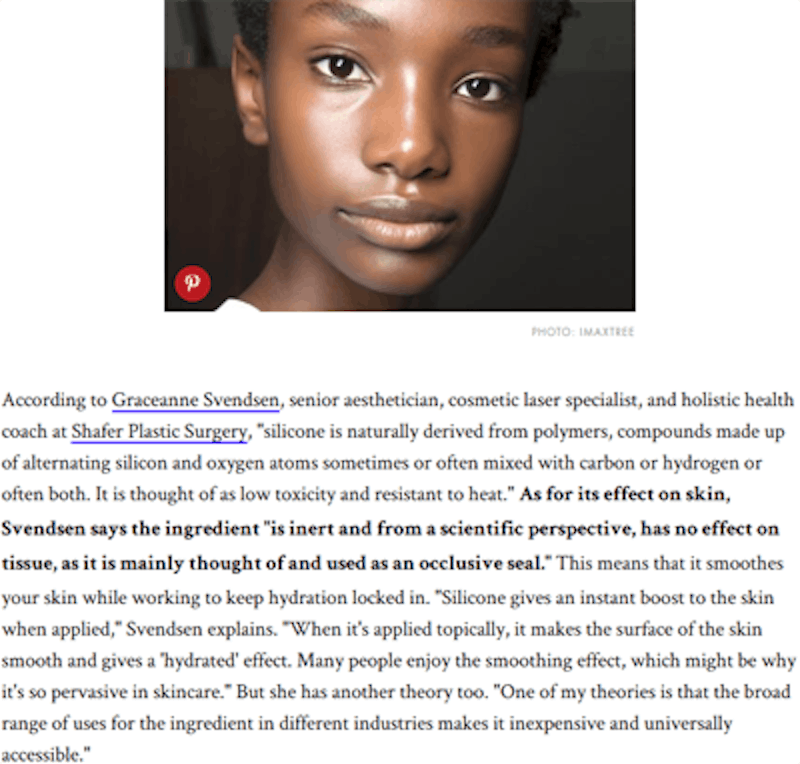
In the world of skincare, there are thousands of different ingredients and formulations. It truly is a “world” because once you start researching which ingredients to seek and which ones to avoid, you start to feel like Alice falling down the rabbit hole, but instead of falling into a wonderland, you fall into a confusing—sometimes contradictory—jumble of reviews, expert testimonies, and science. (Here’s when Alice would exclaim those famous words: “curious and curiouser!”) That’s why it helps to take it step by step, analyzing one ingredient at a time. First, we discussed glycerin, which was followed by glycolic acid and beta-glucan, and now we’re moving onto an ingredient that’s pervasive in skincare: silicone.
It’s an ingredient that carries many implications. For many people, when they see the word at the top of an ingredient list, they call to mind something unnatural, chemical, and maybe even harmful. At least, that seems to be the consensus after taking a quick poll among friends and fellow beauty buffs (very scientific, I know). If it’s that bad, though, why is it found in so many skincare products and brands?
According to Graceanne Svendsen, senior aesthetician, cosmetic laser specialist, and holistic health coach at Shafer Plastic Surgery, “silicone is naturally derived from polymers, compounds made up of alternating silicon and oxygen atoms sometimes or often mixed with carbon or hydrogen or often both. It is thought of as low toxicity and resistant to heat.” As for its effect on skin, Svendsen says the ingredient “is inert and from a scientific perspective, has no effect on tissue, as it is mainly thought of and used as an occlusive seal.” This means that it smoothes your skin while working to keep hydration locked in. “Silicone gives an instant boost to the skin when applied,” Svendsen explains. “When it’s applied topically, it makes the surface of the skin smooth and gives a ‘hydrated’ effect. Many people enjoy the smoothing effect, which might be why it’s so pervasive in skincare.” But she has another theory too. “One of my theories is that the broad range of uses for the ingredient in different industries makes it inexpensive and universally accessible.”
Another perk of using silicone as opposed to other synthetics is that it doesn’t require added chemicals to keep its molecules stable. “Since it has no ‘active’ properties (such as an antioxidant or glycolic acid), silicone is thought of as stable and does not react with other ingredients or break down when exposed to air or light.” This is different than other ingredients (like peptides and essential oils) that require preservatives or stabilizers to keep them from breaking down prematurely. In that light, it doesn’t seem too bad, right? It sounds like a neutral ingredient that doesn’t harm the skin or require other chemicals to preserve. Well, not so fast.
Svendsen is the self-professed “silicone-free queen.” She avoids the ingredient altogether in the name of better skin and hair. “As a certified health coach and celebrity facialist, I advise my clients to eliminate it from their regimen, just as I would guide them toward using less plastic in their everyday lives. When silicone creates that occlusive seal, it suffocates the skin’s natural ability to breath and causes clogged pores.” These suffocating effects are worse for people who have rosacea, acne, sensitive skin, or are prone to milia. As Svendsen recommends, people who experience any of these skin issues should “consider removing silicone from their product lineup.”
So how do you tell if your skincare product is formulated with silicone as an ingredient? It’s not often that you’ll simply see the word “silicone” listed in the fine print. Instead, you should look for words ending in “ane” or “one,” which according to Svendsen, usually refer to a silicone derivative.
As for products that don’t have silicone, Svendsen recommends this potent anti-wrinkle serum from SkinMedica. “One of my favorite products is TNS Recovery Complex, as it is 93% Fibroblast Media (active proteins naturally derived from skin cells called growth factors). Serums work well because their molecules are half the size of that in creams and lotions and absorb well and cleanly into the skin.” She also loves SkinMedica’s Lytera Brightening Complex ($130). “This treatment serum is used for patients with pigment issues, sun damage, melasma, and issues with dull skin. It is one of my absolute all-time top sellers in my almost 15 years as a skincare expert. Its active lightening ingredients are licorice root and kojic acid.”
To summarize, silicone isn’t inherently harmful to skin, but it can cause blemishes and exacerbate existing skin issues, so it’s best to stick to water-based skincare with other active ingredients. Svendsen swears that by eliminating silicone from her routine, her skin (and hair) has never been better. “My teenage daughter and I have the clearest skin and softest hair because we limit, if not have eliminated altogether, silicone from our products. One of my priorities as an aesthetician is to analyze every detail of a patient’s regimen and be able to recognize the signs of a sensitivity.” Please excuse us while we take Svendsen’s advice and comb through the ingredient lists of all our products.


